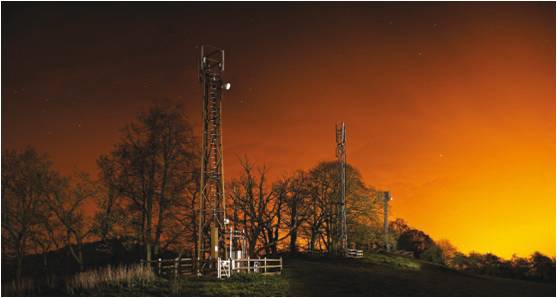By sharing antennas, cellphone companies could save big on energy bills and carbon footprints. But can they stop competing long enough to get along?
YOUR cellphone signal is registering four or five bars, which is good news for subscribers but cold comfort for the network footing the exorbitant bill. To ensure that all subscribers get a strong signal even when few people are using their cellphones in the dead of night, every network in a neighbourhood is broadcasting at full strength from its own base station antenna to the few subscribers who are actually awake.
This needless energy drain could be stopped if cellphone providers could agree to share their antennas on the many occasions when the networks aren’t busy. Traffic is sparse for voice calls outside morning and evening commuting times and in the early evenings when wireless internet usage peaks.
Michela Meo at the Polytechnic University of Turin, Italy, and Marco Marsan at the Madrid Institute for Advanced Studies in Spain came up with an idea for getting networks to cooperate. They ran a simulation in which cellular towers ran software that could progressively switch off their antennas as cellphone activity decreased. Eventually, all the networks could share just a single antenna. The software would then power antennas back up as demand rises (Computer Networks, DOI: 10.1016/j. comnet.2010.10.017). Apart from installing the software on towers, all that is required for the scheme to work is wider use of existing technology that lets cellphones switch from network to network. They estimate that operators could slash annual energy use by up to 20 per cent this way.
That is a saving well worth making, say the researchers, because the 4 million cellphone base stations around the world cost the industry around $10 billion per year in energy bills, as well as releasing 59 million tonnes of carbon dioxide into the atmosphere.
Nice theory, say industry insiders, but the notion is both technically and commercially naive. Paul Eggleton, energy manager at Telefónica O2 in the UK, says companies are well aware of the power issues they face: an astonishing 80 per cent of the cost of running a network goes on its electricity bill.
As a result, the makers of the networks’ radio equipment are beginning to experiment with adaptive power use. “Systems from firms like Huawei, Nokia, Siemens Networks and Ericsson are being cleverly designed to power down when network activity is low,” says Dan Warren, senior technology director at the GSM Association in the UK, a mobile communications advocacy group.
But tests with such equipment have not shown the 20 per cent savings Meo and Marsan predict – and have also brought into sharp relief a major safety issue where emergency calls are concerned. In tests two years ago in which parts of a mock network were switched off as call activity diminished, Eggleton and his colleagues saw modest energy savings of 7 per cent. But once asleep, the antennas often failed to wake back up when demand increased. Any software system would have to address this issue.
“If somebody needs to make an emergency call at 1am they need that connection to be made. So we can’t really look at this idea until it works absolutely seamlessly,” Warren says.
Some of the cooperative measures proposed by the researchers are coming into play through industry mergers and an increasingly popular concept called radio access network (RAN) sharing. With RAN, networks strike deals – like Orange and T-Mobile have in the UK – whereby if one has the stronger network in a particular area, users can roam to it by agreement.
But this accounts for only a small portion of global network traffic. Warren thinks competitive tendencies between companies offering what each regard as distinct – and superior – products mean they will be loath to cooperate en masse.
There are also more technical hurdles. Networks like 3 in the UK, for instance, have largerbandwidth internet connections, but aren’t set up to handle heavy voice traffic. This is because they supply connectivity to a high proportion of USB data dongles on laptops, rather than cellphones, Warren says.
Such objections mean Meo and Marsan have had no luck convincing a network to trial their scheme. The networks are keen to save energy – and its cost – but not to cooperate with each other, Meo says, because voice and data traffic reflect customer usage habits, which companies could use to undercut each other.
Adam Denton, head of regulatory affairs at the GSM Association Industry agrees. “That kind of network cooperation is not going to happen unless it’s enforced by regulators or governments. It’s too fundamental a change.”
|
The juice used by handsets is also coming in for scrutiny – with the way apps are programmed top of the list. Google, inventor of the Android phone, recently funded a study at the University of Cambridge computer lab in which engineers Andrew Rice and Simon Hay examined how some Android apps use power in various handsets (Pervasive and Mobile Computing, DOI: 10.1016/j.pmcj.2010.07.005). They found programmers need to be vigilant about the rapid changes in hardware that can come with each new generation of phone. In one handset, for instance, the Wi-Fi antenna used 10 times as much power as the 3G one. But in the next generation handset the same circuits used the same power. Access to GPS by multiple apps at once can be particularly power-hungry. Rather than allowing each app to take its own powerdraining position fix, he says a phone’s operating system should be designed to allow global position data to be shared between apps. “We also found that phones on the 2G network sometimes consume more power than 3G. It might be something to do with variations in coverage between the networks but we don’t have a hard answer yet,” says Rice. |

Calls are down, one mast will do
Read more:
This article is available at the New Scientist website (by subscription only): Cooperative cellphone networks could cut energy waste
 Download PDF (515 kb)
Download PDF (515 kb)
Author/s: Paul Marks

